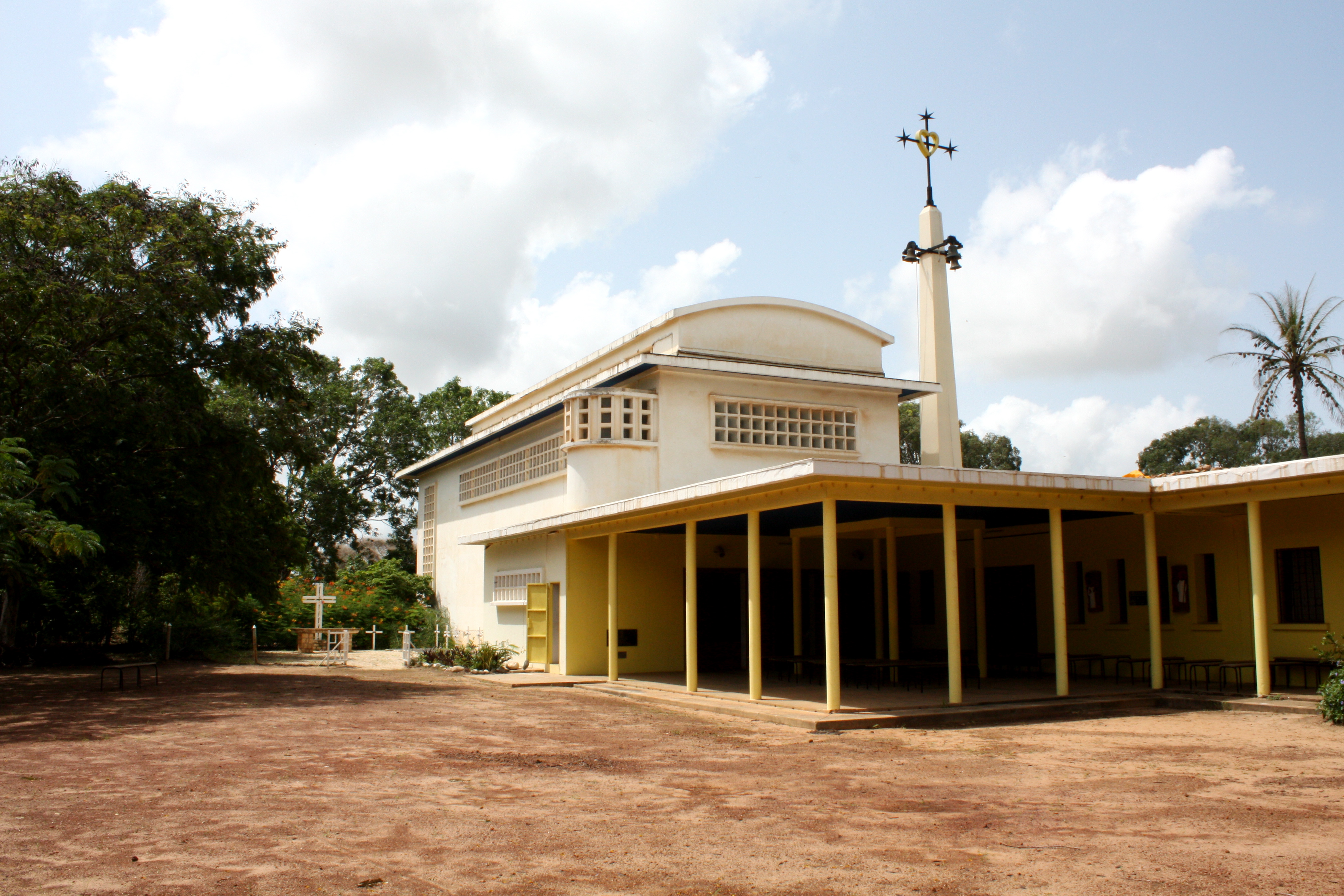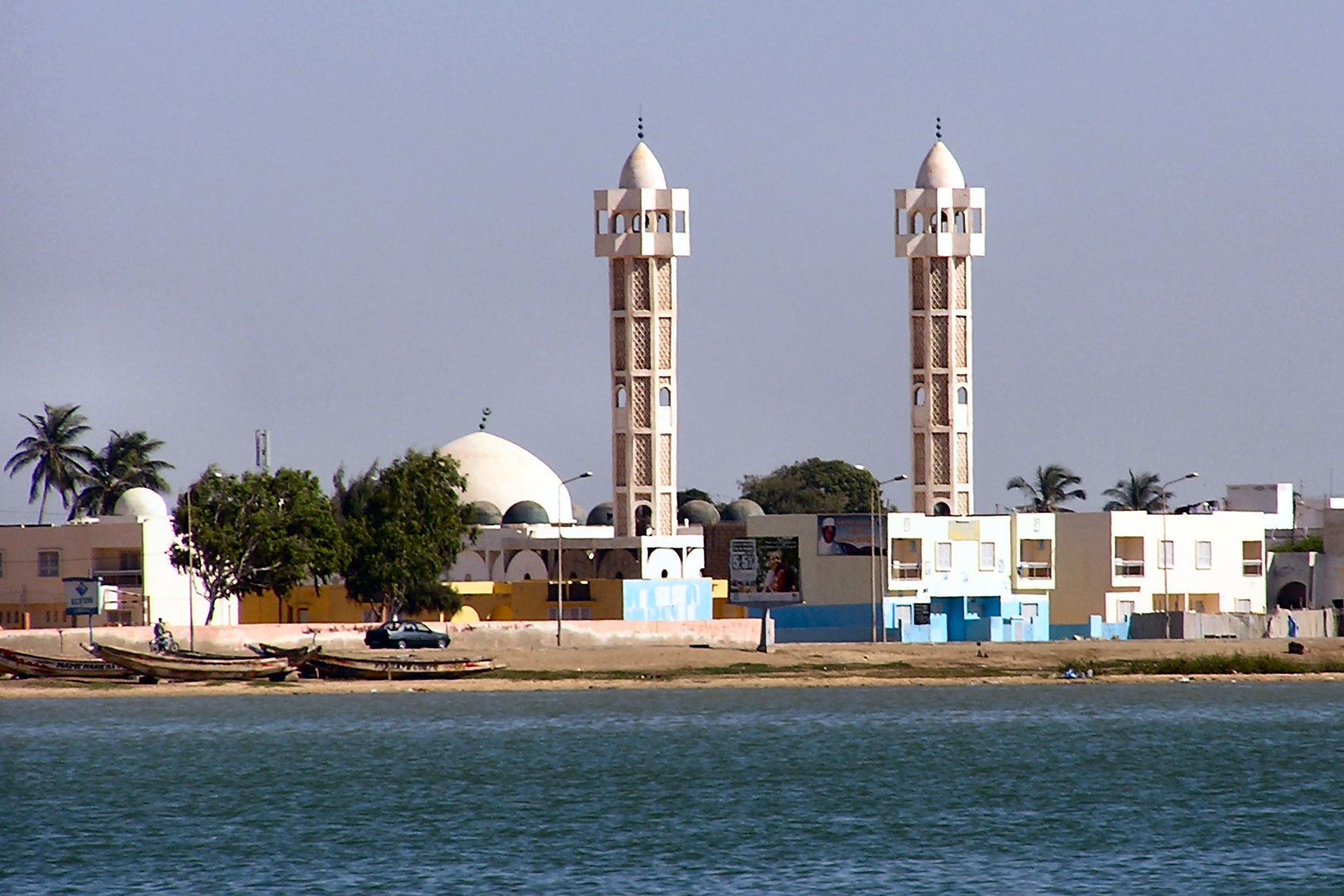|
Abbaye De Keur Moussa
Abbaye de Keur Moussa or simply Keur Mousa, near Dakar, the capital city of the Western African nation of Senegal, is a Benedictine monastery of the Solesmes Congregation. Founded in 1961 by French monks, the monastery became an abbey in 1984. the monastery was home to 26 monks under the leadership of Abbot Fr Philippe Champetier de Ribes Christofle. Recordings done by Sacred Spirit Music demonstrate the monks playing the kora harp and singing, and have reached Western audiences. Their music blends African rhythms and instruments with Western liturgical chant. History In 1961, nine French monks from the Abbey of Solesmes arrived in Senegal to establish a monastic foundation. In the midst of a largely Islamic country, the founding monks aimed to allow Christians the opportunity to take part in the Benedictine life of prayer and work, and to provide non-Christians with an example of such a lifestyle. By 1984, the monastery attained complete autonomy, being raised to the rank ... [...More Info...] [...Related Items...] OR: [Wikipedia] [Google] [Baidu] |
Islam In Senegal
Islam is the predominant religion in Senegal. 97 percent of the country's population is estimated to be Muslim. Islam has had a presence in Senegal since the 11th century. Sufi brotherhoods expanded with French colonization, as people turned to religious authority rather than the colonial administration. The main Sufi orders are the Tijaniyyah, the Muridiyyah or Mourides, and to a lesser extent, the pan-Islamic Qadiriyyah and the smaller Layene order. Approximately 1% are Shiites and <1% are Muslims. History Introduction of Islam  For nearly a millennium, there has been an Islamic presence in Senegal. Islam's in ...
For nearly a millennium, there has been an Islamic presence in Senegal. Islam's in ...
[...More Info...] [...Related Items...] OR: [Wikipedia] [Google] [Baidu] |
Prior
Prior (or prioress) is an ecclesiastical title for a superior in some religious orders. The word is derived from the Latin for "earlier" or "first". Its earlier generic usage referred to any monastic superior. In abbeys, a prior would be lower in rank than the abbey's abbot or abbess. Monastic superiors In the Rule of Saint Benedict, the term appears several times, referring to any superior, whether an abbot, provost, dean, etc. In other old monastic rules the term is used in the same generic sense. With the Cluniac Reforms, the term ''prior'' received a specific meaning; it supplanted the provost or dean (''praepositus''), spoken of in the Rule of St. Benedict. The example of the Cluniac congregations was gradually followed by all Benedictine monasteries, as well as by the Camaldolese, Vallombrosians, Cistercians, Hirsau congregations, and other offshoots of the Benedictine Order. Monastic congregations of hermit origin generally do not use the title of abbot for the ... [...More Info...] [...Related Items...] OR: [Wikipedia] [Google] [Baidu] |
Priesthood (Catholic Church)
The priesthood is the office of the ministers of religion, who have been commissioned ("ordained") with the Holy orders of the Catholic Church. Technically, bishops are a priestly order as well; however, in layman's terms ''priest'' refers only to presbyters and pastors (parish priests). The church's doctrine also sometimes refers to all baptised (lay) members as the "common priesthood", which can be confused with the ministerial priesthood of the consecrated clergy. The church has different rules for priests in the Latin Church–the largest Catholic particular church–and in the 23 Eastern Catholic Churches. Notably, priests in the Latin Church must take a vow of celibacy, whereas most Eastern Catholic Churches permit married men to be ordained. Deacons are male and usually belong to the diocesan clergy, but, unlike almost all Latin Church (Western Catholic) priests and all bishops from Eastern or Western Catholicism, they may marry as laymen before their ordination as cler ... [...More Info...] [...Related Items...] OR: [Wikipedia] [Google] [Baidu] |
Senegalese
Senegal,; Wolof: ''Senegaal''; Pulaar: 𞤅𞤫𞤲𞤫𞤺𞤢𞥄𞤤𞤭 (Senegaali); Arabic: السنغال ''As-Sinighal'') officially the Republic of Senegal,; Wolof: ''Réewum Senegaal''; Pulaar : 𞤈𞤫𞤲𞤣𞤢𞥄𞤲𞤣𞤭 𞤅𞤫𞤲𞤫𞤺𞤢𞥄𞤤𞤭 (Renndaandi Senegaali); Arabic: جمهورية السنغال ''Jumhuriat As-Sinighal'') is a country in West Africa, on the Atlantic Ocean coastline. Senegal is bordered by Mauritania to the north, Mali to the east, Guinea to the southeast and Guinea-Bissau to the southwest. Senegal nearly surrounds the Gambia, a country occupying a narrow sliver of land along the banks of the Gambia River, which separates Senegal's southern region of Casamance from the rest of the country. Senegal also shares a maritime border with Cape Verde. Senegal's economic and political capital is Dakar. Senegal is notably the westernmost country in the mainland of the Old World, or Afro-Eurasia. It owes its name to the Sen ... [...More Info...] [...Related Items...] OR: [Wikipedia] [Google] [Baidu] |
Laity
In religious organizations, the laity () consists of all members who are not part of the clergy, usually including any non-ordained members of religious orders, e.g. a nun or a lay brother. In both religious and wider secular usage, a layperson (also layman or laywoman) is a person who is not qualified in a given profession or does not have specific knowledge of a certain subject. The phrase "layman's terms" is used to refer to plain language that is understandable to the everyday person, as opposed to specialised terminology understood only by a professional. Some Christian churches utilise lay preachers, who preach but are not clergy. The Church of Jesus Christ of Latter-day Saints uses the term ''lay priesthood'' to emphasise that its local congregational leaders are unpaid. Terms such as ''lay priest'', ''lay clergy'' and ''lay nun'' were once used in certain Buddhist cultures to indicate ordained persons who continued to live in the wider community instead of retiring t ... [...More Info...] [...Related Items...] OR: [Wikipedia] [Google] [Baidu] |
Primary School
A primary school (in Ireland, the United Kingdom, Australia, Trinidad and Tobago, Jamaica, and South Africa), junior school (in Australia), elementary school or grade school (in North America and the Philippines) is a school for primary education of children who are four to eleven years of age. Primary schooling follows pre-school and precedes secondary schooling. The International Standard Classification of Education considers primary education as a single phase where programmes are typically designed to provide fundamental skills in reading, writing, and mathematics and to establish a solid foundation for learning. This is ISCED Level 1: Primary education or first stage of basic education.Annex III in the ISCED 2011 English.pdf Navigate to International Standard Classification of Educati ... [...More Info...] [...Related Items...] OR: [Wikipedia] [Google] [Baidu] |
Dispensary
A dispensary is an office in a school, hospital, industrial plant, or other organization that dispenses medications, medical supplies, and in some cases even medical and dental treatment. In a traditional dispensary set-up, a pharmacist dispenses medication per the prescription or order form. The English term originated from the medieval Latin noun and is cognate with the Latin verb '' dispensare'', 'to distribute'. The term also refers to legal cannabis dispensaries. The term also has Victorian antiquity, in 1862 the term dispensary was used in the folk song the Blaydon Races. The folk song differentiated the term dispensary from a Doctors surgery and an Infirmary. The advent of huge industrial plants in the late 19th and early 20th centuries, such as large steel mills, created a demand for in-house first responder services, including firefighting, emergency medical services, and even primary care that were closer to the point of need, under closer company control, ... [...More Info...] [...Related Items...] OR: [Wikipedia] [Google] [Baidu] |
Muslim
Muslims ( ar, المسلمون, , ) are people who adhere to Islam, a monotheistic religion belonging to the Abrahamic tradition. They consider the Quran, the foundational religious text of Islam, to be the verbatim word of the God of Abraham (or '' Allah'') as it was revealed to Muhammad, the main Islamic prophet. The majority of Muslims also follow the teachings and practices of Muhammad ('' sunnah'') as recorded in traditional accounts (''hadith''). With an estimated population of almost 1.9 billion followers as of 2020 year estimation, Muslims comprise more than 24.9% of the world's total population. In descending order, the percentage of people who identify as Muslims on each continental landmass stands at: 45% of Africa, 25% of Asia and Oceania (collectively), 6% of Europe, and 1% of the Americas. Additionally, in subdivided geographical regions, the figure stands at: 91% of the Middle East–North Africa, 90% of Central Asia, 65% of the Caucasus, 42% of Southeast As ... [...More Info...] [...Related Items...] OR: [Wikipedia] [Google] [Baidu] |
Kora (instrument)
The kora (Manding languages: ''köra'') is a stringed instrument used extensively in West Africa. A kora typically has 21 strings, which are played by plucking with the fingers. It combines features of the lute and harp. Description The kora is built from gourd, cut in half and covered with cow skin to make a resonator with a long hardwood neck. The skin is supported by two handles that run underneath it. It has 21 strings, each of which plays a different note. These strings are supported by a notched, double free-standing bridge. The kora doesn't fit into any one category of musical instrument, but rather several, and must be classified as a "double-bridge-harp-lute." The strings run in two divided ranks, characteristic of a double harp. They do not end in a soundboard but are instead held in notches on a bridge, classifying it as a bridge harp. The strings originate from a string arm or neck and cross a bridge directly supported by a resonating chamber, also making it a lute ... [...More Info...] [...Related Items...] OR: [Wikipedia] [Google] [Baidu] |
West Africa
West Africa or Western Africa is the westernmost region of Africa. The United Nations defines Western Africa as the 16 countries of Benin, Burkina Faso, Cape Verde, The Gambia, Ghana, Guinea, Guinea-Bissau, Ivory Coast, Liberia, Mali, Mauritania, Niger, Nigeria, Senegal, Sierra Leone, and Togo, as well as Saint Helena, Ascension and Tristan da Cunha ( United Kingdom Overseas Territory).Paul R. Masson, Catherine Anne Pattillo, "Monetary union in West Africa (ECOWAS): is it desirable and how could it be achieved?" (Introduction). International Monetary Fund, 2001. The population of West Africa is estimated at about million people as of , and at 381,981,000 as of 2017, of which 189,672,000 are female and 192,309,000 male. The region is demographically and economically one of the fastest growing on the African continent. Early history in West Africa included a number of prominent regional powers that dominated different parts of both the coastal and internal trade networks, suc ... [...More Info...] [...Related Items...] OR: [Wikipedia] [Google] [Baidu] |
Goat Cheese
Goat cheese, or chèvre ( or ; from French language, French ''fromage de chèvre'' 'goat cheese'), is cheese made from goat's milk. Goats were among the first animals to be domesticated for producing food. Goat cheese is made around the world with a variety of recipes, giving many different styles of cheese, from fresh and soft to aged and hard. Properties History Goats produce high quality, nutrition-rich milk under even the most difficult environments making them valuable to arid or mountainous areas where cows and sheep can not survive. Goats were one of the earliest animals domesticated to suit human needs- more specifically milk production- going back to 8,000 B.C., 10,000 years ago. Goat cheese has been made for at least as far back as 5,000 B.C. Meanwhile, the first documented proof of humans making cheese is 7,500 years ago in Poland. Nutritional value Goat milk has a higher proportion of medium-chain fatty acids such as Hexanoic acid, caproic and caprylic acid, ... [...More Info...] [...Related Items...] OR: [Wikipedia] [Google] [Baidu] |



.jpg)





